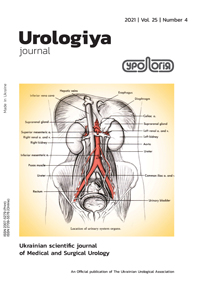Experience of percutaneous nephrolithotripsy of large kidney stones
DOI:
https://doi.org/10.26641/2307-5279.26.1.2022.260486Keywords:
percutaneous nephrolithotripsy, kidney stone disease, staghorn stonesAbstract
Topicality. Kidney stone disease is referred to wide spread diseases. According to the literature data its prevalence is 732,8 cases per 100 000 of Ukrainian population. During the last years the usage of minimally invasive techniques, such as: extracorporeal shock-wave lithotripsy (ESWL) and ureteroscopy with contact lithotripsy has significantly increased, but percutaneous lithotripsy (PNL) remains as a technique of choice among basic methods of treatment of large size kidney stones.
The purpose of the work. To evaluate the effectiveness of the percutaneous shock wave lithotripsy (PNL) in treatment of kidney stones larger than 50 mm.
Materials and methods. Twenty-eight patients, among them twenty-five (89,28%) male patients and three (10,71%) female patients, with large > 50 mm kidney stones treated in NMMCC from April 2016 to March 2020 were included to the research. Stone-free rate and complications rates were examined.
Results. In thirteen cases (46.42%) the stones were located in the right kidney, in fifteen cases (53,57%) the stones were located in the left kidney. The nineteen patients (67,85%) did not have any residual stones, and nine patients (32,14%) had residual stones. The extracorporeal shock-wave lithotripsy had been performed in 4 patients (14%), in 5 (17%) cases – contact lithotripsy of residual stones, which migrated to the lower third part of the ureter. After repeated intervention in 5 cases (17,86%) stone-free status was obtained. Stone-free rate index was 85,71%. Average duration of operation was 115±24,64 min. Hemoglobin level before and after operative intervention was 142 (117–159) g/l and 119 (94–132) g/l respectively (р <0,005). Length of hospital stay was 5,07 (4–9) days. Complications were observed in six patients (21,5%). Stone-free status was defined as absence of any residual stones during radioscopy at 1 day after the operation or during computer tomography after 3 months. Residual stones d Ј 4 mm and > 4 mm were considered as insignificant and significant respectfully.
Conclusions. Percutaneous nephrolitotripsy is an effective and reliable method of treatment and should be a method of choice in treatment of staghorn stones and large size stones of the kidneys.
References
Pietropaolo A., Reeves T., Aboumarzouk O., Kallidonis P., Ozsoy M., Skolarikos A., Somani B.K. Endourologic management (PCNL, URS, SWL) of stones in solitary kidney: A systematic review from European association of urologists young academic urologists and uro-technology groups. Journal of endourology. 2020. 34(1). Р. 7–17.
Haghighia R., Zeraatib Н. Ultra-mini-percutaneous nephrolithotomy (PCNL) versus standard PCNL: A randomised clinical trial. Arab Journal of Urology. 2017. 15(4). Р. 294–298.
Reeves T. et al. Role of endourological procedures (PCNL and URS) on renal function: a systematic review. Current urology reports. 2020. 21(5). P. 1–11.
Akman T., Binbay M., Kezer C., Yuruk E., Tekinarslan E., Ozgor F. et al. Factors affecting kidney function and stone recurrence rate after percutaneous nephrolithotomy for staghorn calculi: outcomes of a long-term follow up. J Urol. 2012. 187(5). P. 1656–1661.
Fernstrom I., Johansson B. Percutaneous pyelolithotomy. A new extraction technique. Scand J UrolNephrol. 1976. 10(3). P. 257–259.
Ketsuwan C. et al. Peri-operative factors affecting blood transfusion requirements during PCNL: a retrospective non-randomized study. Research and reports in urology. 2020. 12. P. 279.
El-Nahas A.R., Eraky I., Shokeir A.A., Shoma A.M., el-Assmy A.M., el-Tabey N.A. et al. Factors affecting stone-free rate and complications of percutaneous nephrolithotomy for treatment of staghorn stone. Urology. 2012. 79(12). P. 1236–1241.
Desai M., DeLisa A., Turna B., Rioja J., Walfridsson H., D’Addessi A. et al. The clinical research office of the endourological society percutaneous nephrolithotomy global study: staghorn versus nonstaghorn stones. J Endourol. 2011. 25(1). P. 11–17.
Netto N.R. Jr., Ikonomidis J., Ikari O., Claro J.A. Comparative study of percutaneous access for staghorn calculi. Urology. 2005. 65(4). P. 659–662.
Білай С.І., Довбиш М.А. Дослідження функціонального стану нирок та показників метаболічних порушень у хворих на уретний нефролітіаз коморбідний з метаболічним синдромом. Клінічна та експериментальна медицина. 2019. № 3. С. 70–76.
Сайдакова Н.О. Загальна картина стану урологічної служби, основних показників діяльності, епідеміологічних процесів в Україні (2016-2017 роки). Урологія. 2018. № 3. С. 6–9.
Downloads
Published
Issue
Section
License
Стаття повинна мати візу керівника та офіційне направлення від установи, з якої виходить стаття (з круглою печаткою), і вказівкою, чи є стаття дисертаційною, а також у довільній формі на окремому аркуші - відомості про авторів (прізвище, ім’я, по батькові, посада, вчений ступінь, місце роботи, адреса, контактні телефони, E-mail).
Стаття повина бути підписана всіма авторами, які укладають з редакцією договір пропередачу авторських прав (заповнюється на кожного автора окремо з оригінальним підписом). За таких умов редакція має право на її публікацію та розміщення на сайті видавництва.

